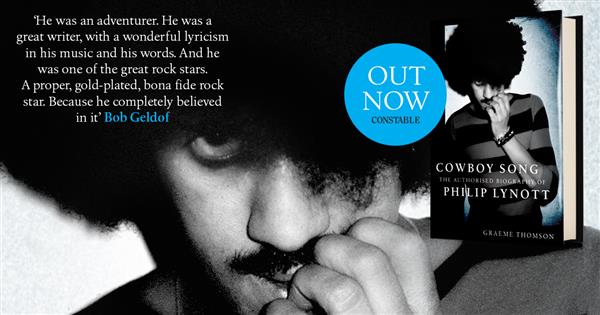|
Cowboy Song The Authorized Biography of Philip Lynott
BELOW is an exclusive preview ... |
|
In 1963, the 14-year-old Lynott joins local beat group the Black Eagles as their singer, alongside Frankie Smith and Hugh Feighery on guitars, Frankie’s brother Danny on bass and Mick Higgins on drums. He was already a local star – tall, skinny, legs like drainpipes. He was growing into the long, doleful face, with its sleepy smile and big, heavy-lidded eyes peering out from under his brow, a melting look practised and perfected in front of the mirror at Leighlin Road and later unleashed to devastating effect at the dances and discos of south Dublin. There was something wonderfully cartoonish about Lynott, an air of Dennis the Menace mischievousness that stuck with him. The low, shoulder-shaking hur hur hur of a laugh deserved its own cartoon bubble over his head. He couldn’t play a musical instrument or write songs, but he could hold a tune and he loved music. He and his uncle Peter would listen to the top twenty on Radio Luxembourg every Sunday night in bed on the transistor radio that his mother had bought for him. At Christmastime and family parties he needed little encouragement to perform a turn, despite being an essentially shy boy. He spoke softly, and scrunched up his long frame to make himself appear less tall, less conspicuous. ‘He could be self-conscious about things,’ says Frank Murray, one of his closest friends and later Thin Lizzy’s tour manager. ‘That continued into Thin Lizzy. You can walk out on stage and look at a crowd of 5,000, or 20,000 people, and you can still be shy. I can watch films of Philip and point out his shy body language. I can see certain stage traits he had and where they came from. Paradoxically, he had a lot of confidence about a lot of other things. You have to have that to get up and sing in the first place, and it takes a certain amount of self-confidence to start working, and to get through the bad stuff in order to get to the good stuff.’ He was popular. Interesting and unusual things tended to happen around him. A fellow Crumliner, Martin Duffy recalls that on one rare summer day when the Southside streets were hazy with heat and promise, Lynott peeled a strip of sticky tarmac from the surface of Leighlin Road and rolled it into his mouth. He had a naturally egalitarian streak which ensured that his friendships were always diverse. ‘He didn’t look down his nose at anyone,’ says Michael O’Flanagan, who befriended Lynott in the 1960s while filming and photographing many local bands. ‘He was a bit like Cassius Clay – "I’m the greatest, but that doesn’t mean you’re a pygmy.’" He seemed to offer something for everyone: a laugh and a dirty joke for friends at school; a touch of swagger for the tough lads; exotic good looks for the more adventurous girls; talent, knowledge and enthusiasm for the musos; a quiet, soulful side for the poets and introverts. ‘He was three years older than me, but there was only a year between us in school,’ says Martin Duffy. ‘He was in the lower grade, and I was a bright nerd. Somehow we made friends, and there was mutual respect. There was something sensitive in there that I could relate to. He was a very open guy. I liked him a lot.’ And the girls already loved him. Why on earth wouldn’t you want him in your band? As the Black Eagles developed, rehearsals moved from the bedroom of the Smiths’ home at 15 Leighlin Road to the Feighery residence at 117 Leighlin Road. There were two tin sheds in the garden to accommodate the overspill of a family of twelve. The smaller shed, a cosy 12 x 12 foot, was cleared out to create a practice space. This caused a minor stir locally. Crumlin kids would come down to listen to the music, ‘fluting around’ outside the door as the sound of the Mersey, the Hudson and the Thames leaked out. ‘I’d knock on their bell on the way back from the boxing club because it was very enjoyable to listen to,’ says Lynott’s school mate Kevin Horan. ‘There was always a few kids hanging around, and usually some girls.’ From the start, Lynott approached the idea of being the lead singer in a band with dedication. ‘Philip would insist every day after school, “Come on, I want to do a bit of practising, you get the guitar and I’ll sing,”’ says Hugh Feighery. ‘We literally went to school and then went straight back to his place. This was outside the standard practice we would do with the band. He lived it. He got a high when he sang, although he was a very shy person.’ Already, the notion of a career was crystallizing. He told Feighery, ‘I’m black, I’m Irish and I’m a bastard – if I don’t make it as a singer I’m never going to make it.’ Now available at AMAZON and other fine stores. Who is Graeme Thomson?
Graeme Thomson has written for Esquire,
He is the author of biographies on |
And a warm THANK YOU to these people for their support.
Home![]()
![]() Thin Lizzy
Thin Lizzy![]() Counting Crows
Counting Crows![]() jt's E-MALL
jt's E-MALL![]() Search
Search![]() Other JT
Other JT![]() MP3
MP3
